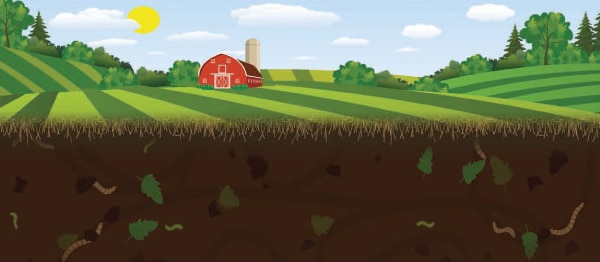By Lisa Blazure, Pennsylvania No-Till Alliance
(This article originally appeared in our 2017 Annual Report.)
 The discussion of soil health has moved beyond agricultural circles and now involves mainstream media and those outside of the farming community. The universal quality about improving soil health is that it applies to any scale of food production — from the backyard garden to the ten-acre organic farm to the thousand-acre conventional farm. It is revolutionizing agriculture and changing conversations, education programs, and on-farm management.
The discussion of soil health has moved beyond agricultural circles and now involves mainstream media and those outside of the farming community. The universal quality about improving soil health is that it applies to any scale of food production — from the backyard garden to the ten-acre organic farm to the thousand-acre conventional farm. It is revolutionizing agriculture and changing conversations, education programs, and on-farm management.
Soil Is a Diverse, Dynamic Ecosystem
Instead of viewing soil as an inert medium that only provides nutrients and water to a growing plant, soil health management recognizes that the soil is a diverse, dynamic ecosystem that, under proper management, will support healthy crops with fewer inputs. Healthy soils are a win for the farmers, and also a win for the environment.
Soil health management follows four basic natural principles: always have a living plant in the soil, minimize the amount of soil disturbance, keep the soil covered with the previous crop residue, and maximize diversity in the system.
Cover Crops and No-Till Practices

A key management aspect is planting a cover crop in the fall after the main crop harvest. Living plant roots are critical for building soil carbon; the main component of organic matter. Roots exude simple sugars that feed the soil microbes (primarily bacteria and fungi) and pump carbon into the system. The soil biology also creates a porous, crumbly soil structure that allows rainwater to infiltrate and reduces the amount of stormwater runoff to local waterways.
No-till planting is another key management practice. By eliminating plowing and tilling, soils are less prone to erosion and can build organic matter more quickly. Undisturbed soil can better support a vast underground network of fungi that taps into the plant root system and scavenges water and nutrients to feed the crops.
Positive Changes

Soil health includes bringing diversity back into farm systems. This can involve adding more crops in the rotation, planting multi-species cover crops, and adding grazing animals to the farm. Diverse natural systems are more resilient to weather extremes, pests, and disease outbreaks.
Soil health management is gaining momentum in the agricultural community. Farmers adopting these practices are seeing positive changes in their fields and their crops. Some have even begun reducing fertilizer and pesticide inputs. These positive changes in land management should have a lasting effect on the quality of local water resources.
Natural Principles for Soil Health Management
- Always have a living plant in the soil. Roots and soil biology create porous, crumbly soil that allows rainwater to infiltrate and reduces the amount of stormwater runoff to local waterways.
- Minimize the amount of soil disturbance. Undisturbed soil can better support a vast underground network of fungi that taps into the plant root system and scavenges water and nutrients to feed the crops.
- Keep the soil covered with the previous crop residue. No-till planting, and eliminating plowing/ tilling can reduce erosion and helps build organic matter in the soil.
- Maximize diversity in the system. Diverse natural systems are more resilient to weather extremes, pest, and disease outbreaks.
Learn more about soil health from the National Resources and Conservation Service.



